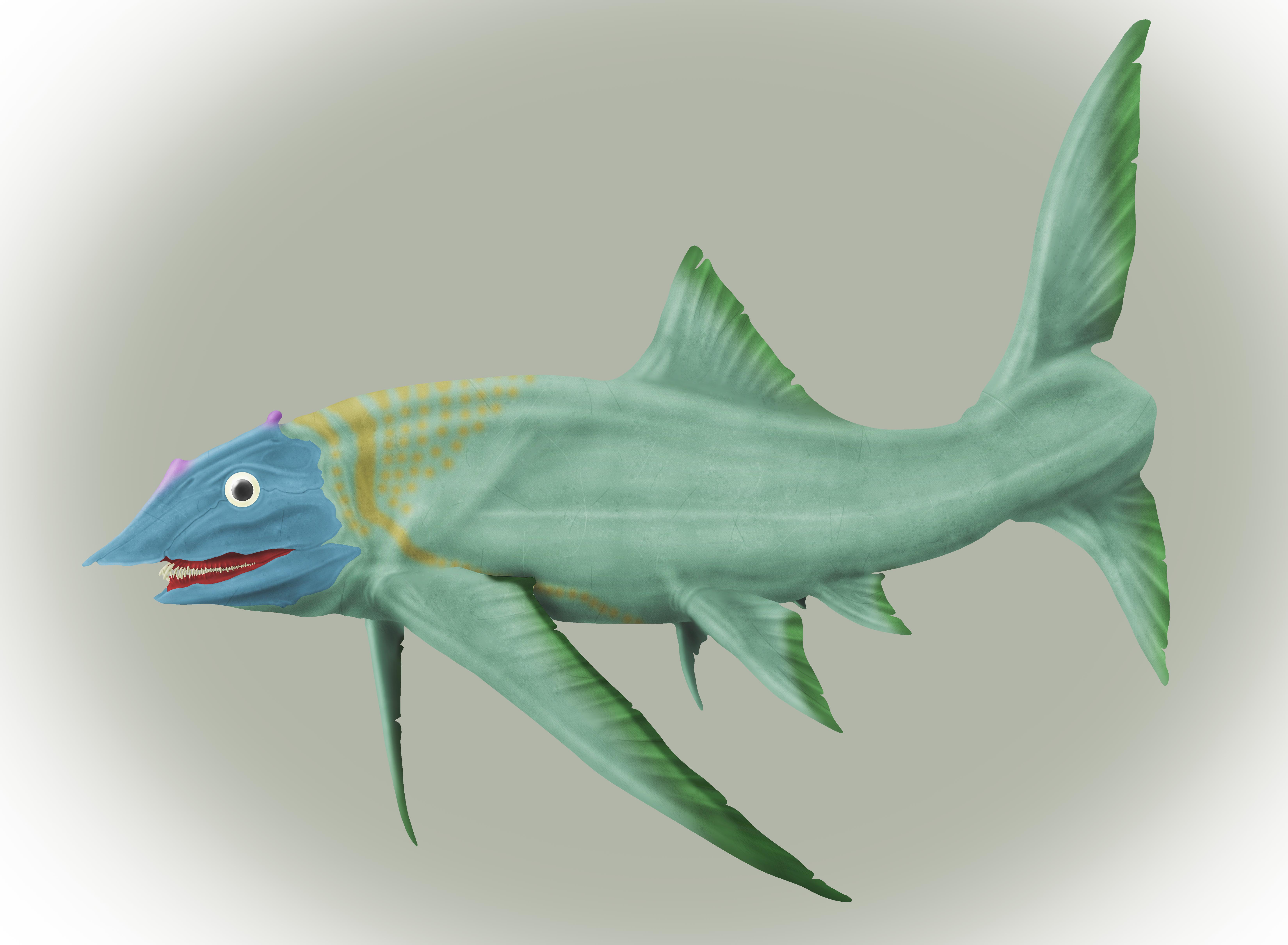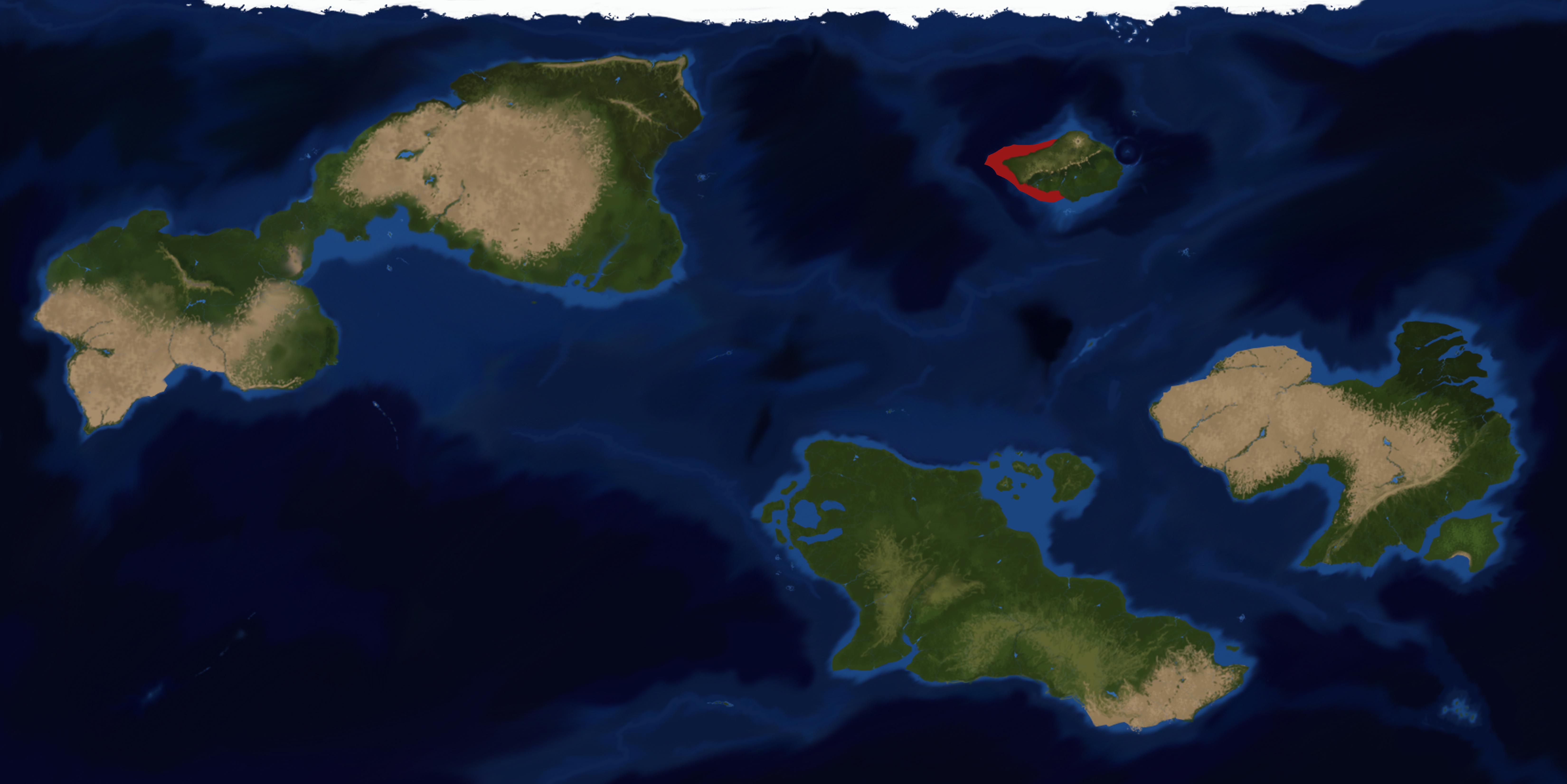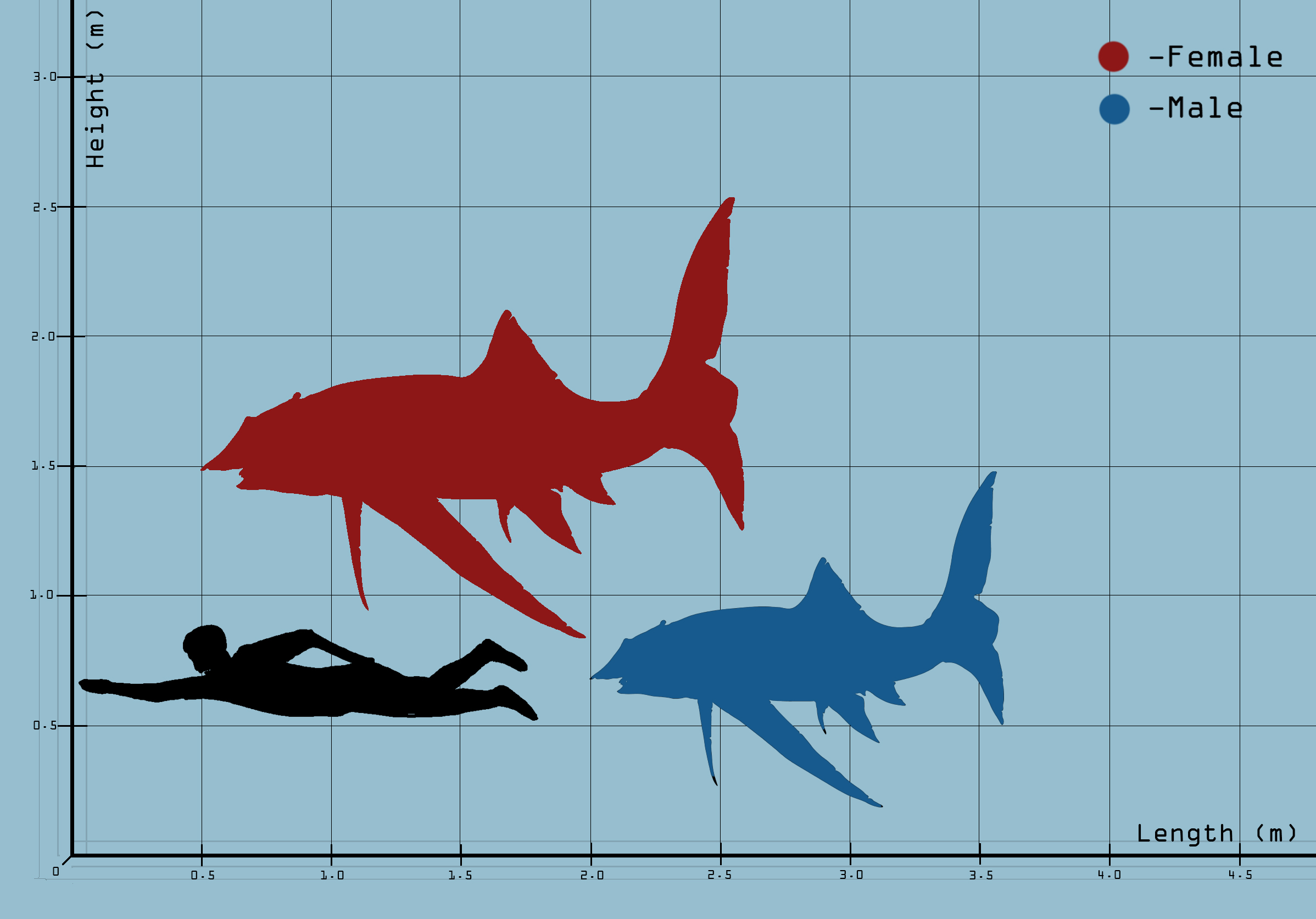Yellowback Ploughead
Aratrocarcharias brevirostris is a species of Aratropiscine Tubercolosthomatosoid amphibian from the waters of the Balloon forests west of Gleann Blathànna.
It lives close to the seafloor under the cover of the balloon forests, in the Tree graveyard below, where it will prowl the dense vegetation bed in search of small prey animals.
Compared to other more derived Aratropiscines, the rostrum of this species is much shorter and laterally compressed in part because of its basal place in the subfamily but also because of its hunting style.
Without the need to dig deep into the sand, the animal only needs to superficially rummage in the dense vegetation of seagrass, young Balloon sprouts and dead mature ones, a condition in which superior vision and cranial mobility are favoured.
In the vegetation-thick environment in which it's found, azure or blue hues wouldn't work as well in camouflaging the animal against predators, thus it adapted a green colouration to serve the same purpose. The absence of countershading is not due to it swimming close to the seafloor, as it will often move at medium depths too, but because even above it the vegetation is thick enough as to paint the water green.
A. brevirostris specialized in hunting animals such as small Philloichthyds and Selenopiscoids that find refuge among the grass but will also run after Galeocristatoids and Sandcreepers, in areas open enough.
While only superficially resembling Aratrocephalus extremum, the species is in reality much more basal, with a series of Plesiomorphies (ancestral characters) that differentiate the two enough as to justify the genus change, although still very debated to this day.
Among these Plesiomorphic characteristics, the most important are the still unfused jaw which, even if it can't open anymore, is not closed by a true suture as well as the presence of a pseudotuberculus inside the mouth as the palatine and the outer wall of the former are not yet merged.
The species suffered the effects of anthropic activities in several instances:
-It was overfished during the first half of the 2400s by massive trawlers, which damaged the benthic environments
-It suffers habitat loss due to humans reclaiming sections of the forests for cultivations and amphibian farms
-It suffered losses due to humans sportfishing the species
The species had originally two known subspecies, however only one's extant to this day.
-†A. brevirostris brevirostris was officially declared extinct in 2546 after more than thirty years from the last known sighting.
This subspecies inhabited the more open areas of the forests, was sandier coloured and hunted more actively than its extant kin.
It was driven to extinction due to heavy habitat loss, overharvesting of its main prey species and sportfishing.
-A. brevirostris Gleannensis has a more pronounced rostrum and chases prey much less, preferring to scare them out en masse and pick off the slowest or simply intercepting fleeing animals with small boosts.
Basic Information
Anatomy
- Head triangular, rostrum shorter than other Aratropiscids.
- Two small knob-like protrusions grow on the dorsal area of the skull.
- Gum exposed, teeth serrated.
- Pectoral fins large and moved horizontally to the body, triangular in shape.
- Anal I & II trapezoidal.
- Dorsal fin veiled and triangular.
- Gill Tail long, roughly the same height of the second half of the body.
- Gill Fan very rounded, caudal drop steep.
- Upper caudal fin visibly longer than the lower.
Genetics and Reproduction
Seasonally Monogamous species.
A. brevirostris mates in the Spring.
Males of the species will build a nest in clearings in the forest floor or creating them by uprooting seagrass and clearing away dead balloon trees with the rostrum.
An average nest is circular, bordered with small rocks and other hard objects; the inside is decorated by the animal with patterns dug in the sediment by the rostrum or tip of the fins.
Passing females will judge the nest based on the regularity of its shape, the complexity of the patterns in its centre and the order of the objects on its extremities; if she judges the nest adequate for her needs she'll occupy it with her body, letting the male court her through several ritual dances.
A male will court the female by swimming around her, tapping her body gently with the head and caressing her with his body; during this time, the female won't move and will let him take the lead, getting nudged gently to the sides and even carried by him.
As a final test, the male will have to bring her a food offering to demonstrate he'll be able to provide for her while she incubates the eggs.
Mating is prefaced by long mating dances where both male and female will swim in circles close to the seafloor, touching pectoral fins; They will then start the ritual sparring, in which both will gently charge one another just to move to one side before hitting the partner.
The female will incubate the eggs inside the duct for twelve days, during this time she'll still hunt for herself and only return to the nest to rest.
Deposition of the eggs is done in a small hole she'll dig in the centre of the nest, she'll then cover the eggs with the loose sediment and finally sit on top of it, where she'll guard them until they hatch; during this period the male will have to provide for her, bringing her food and grooming her skin daily as this inactive state leaves her exposed to many parasites.
The eggs will hatch two weeks later, the female will dig them out of the mound beforehand to ensure their birth.
Both parents will nurture the young to adulthood, the father will leave his nesting grounds to the female and his offspring once they are big enough to fend for themselves.
The offspring will leave the mother one year after being born when the female will start looking for a new mate.
Growth Rate & Stages
Ontogenesis in the species visible.
Young specimens possess a more segmented armour, a wider rostrum and more symmetrical Caudal fins.
Loss of natal aculeus four weeks after birth.
Ecology and Habitats
Epipelagic creature found living at depths between 30 and 70 m.
Lives around the shallow forest floor under the Balloon forests, it prefers areas with dense vegetation.
Dietary Needs and Habits
Carnivorous animal that uses the specialized rostrum and long pectoral fins to scare prey from the vegetation.
It hunts anything from Philloichthyds, Selenopiscoids, Galeocristatoids and even small tubercolostomatosids.
Biological Cycle
Seasonal species that follows the activity patterns of prey animals in the winter season.
Contrary to several other animals it won't stop prowling its territories during the winter but will instead switch its hunting tacting to discovering the burrows of preys and digging them out of them.
Additional Information
Social Structure
Not incredibly social, they will tolerate conspecifics even outside of family groups when feeding.
Females are often accompanied by their offspring, communicating with them through guttural clicks.
Domestication
By nature friendly towards humans, it became skittish towards them after years of hunting pressure on them.
Certain small populations of the inner forests still retain some friendliness towards divers, although they can still potentially be dangerous.
Kept in a very small number of public aquariums for conservation purposes.
Uses, Products & Exploitation
The animal still retains moderate economic interest for human consumption and as game for sportfishing.
Given the quite fragile nature of the remaining populations, several institutions are taking action to ensure the species' continued survival.
Perception and Sensory Capabilities
Good eyesight and electrolocation.
Symbiotic and Parasitic organisms
Afflicted by several skin parasites and Intestinal Tube Worms.
Scientific Name
Enetodontia; Enetodontida; Paleosthomatosoidea; Tubercolosthomatosoidea; Aratropiscidae ; Aratropiscinae; Aratrocarcharias; A. brevirostris
Lifespan
35 Years
Conservation Status
Vulnerable: Even though it suffered a lot due to anthropic activity, the species still thrives in the deepest reaches of the Balloon forests, where little human intervention is present; Enjoys limited protections from the TWPP
Population Trend: DECLINE
Average Weight
60-190 kg
Body Tint, Colouring and Marking
Green to lime body, armour azure to blue.
Gums bright red.
Cranial knobs purple, first section of the back striped in yellow.
Fins tipped in a darker green.
Remove these ads. Join the Worldbuilders Guild












Comments